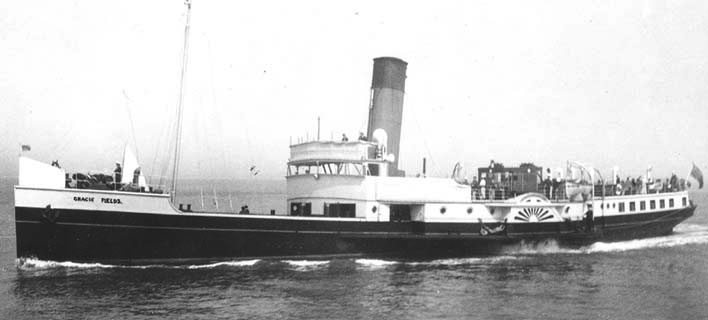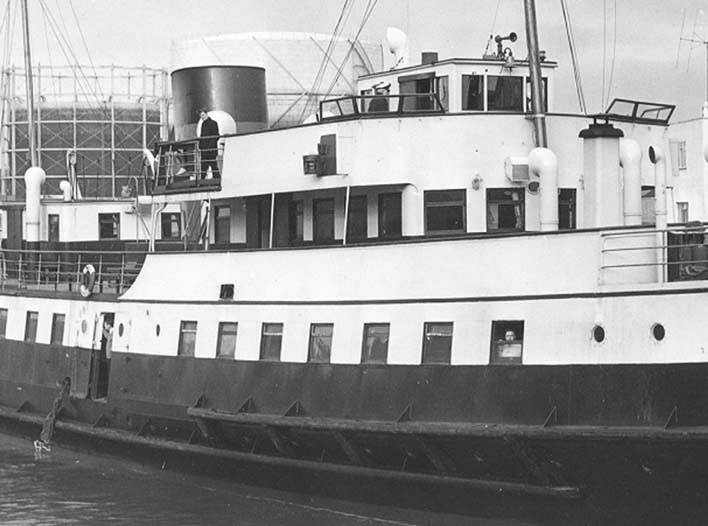
The Balmoral came to Cosens’s yard in Weymouth for her annual maintenance and refit each winter from 1964 for the remainder of her career with Red Funnel and again in the early years of her long term charter to P & A Campbell on the Bristol Channel from 1969. Here she is sailing through the Town Bridge outward bound coming up to the Consul, the bow of which can be seen in the bottom left of the picture.

Lying there in the Weymouth Backwater astern of the paddle steamer Embassy and her former Red Funnel fleet mate Princess Elizabeth, the Balmoral always seemed to my young eyes, as I cycled by on the way to school, to be the final development of the Southampton/Isle of Wight paddle steamer. OK, she didn’t have paddle wheels. She didn’t have a steam engine. She was built to an altogether more modern, up to date design but, but, but, (and we need three buts here!) she was about the same length, breadth and draught as her Backwater neighbours. She was of a similar layout. And she had the feel about her of being a modern version of a paddle steamer minus the wheels. Goodness, she even had an open engine room with windows in the alleyways so that interested passengers could peer in (just like on the paddle steamers) and see the magnificent Diesel engines (not quite like on the paddle steamers) if not rotating with all the mesmeric delight of steam, at least vibrating steadily if noisily.

And that is not so surprising in that things didn’t change very fast in Southampton/Isle of Wight paddle steamer design. For example, the Duchess of Cornwall, built in 1896, and seen here arriving at Southampton, was an only slightly enlarged and enhanced version of the Southampton and Carisbrooke of 1870 and 1876 respectively with two saloons below deck, one forward and one aft of the engine and boiler rooms, an open foredeck which could be used by cars on the Southampton to Cowes ferry, a main deck saloon aft and an open promenade deck.

The Princess Mary of 1911 was again more of the same as was the Princess Elizabeth of 1927 seen here arriving at Southampton in the 1950s with a good load of both cars and passengers. Yes she was a very slightly modernised version of the Duchess of Cornwall but not very much so even though they were built thirty years apart.

Then came change in a big way in the form of the Medina of 1931. And this really was change. She was not at all like her predecessors. She was powered by Diesel. She was of a radically different hull design and had a very flared bow which, overhanging the hull below as it did, proved troublesome alongside piers leaving the ship more suited to working the pontoons at Cowes and Southampton than running to the Island piers.

Whatever success this change of design may or may not have been thought to bring, for their next ship, new and radical design was thrown out of the window and Red Funnel returned to their comfort zone with the Gracie Fields of 1936 which was basically another Princess Elizabeth with slight upgrades. The most notable of these were a rubbing band around the top of each paddle box to prevent damage when the ship had a list with lots of passengers on one side alongside a pier or when tendering a liner; a bow rudder for ease of backing out of Cowes and turning at Southampton; and a forecastle which provided a bit of extra shelter on the foredeck. With winter gales blowing against the tide the waters between Calshot and Cowes can be quite rough and doubtless the ever increasing number of owners of expensive cars travelling on the ships would have been rather less than pleased to see their leather seated and highly polished dream possessions being given a liberal dose of salt spray on the passage over.

Having taken one step forwards with the Medina and two steps back with the Gracie Fields, Red Funnel’s next ship, the Vecta of 1939, succeeded in combining both the old and the new. She was a radical development in that she was only the second ship in the UK to be powered by the then very novel Diesel Voith Schneider propulsion units. But the basic hull design was really just an improved version of the Gracie Fields without the paddle wheels and with a couple of deckhouses on the promenade deck.
At first glance, unlike the Gracie Fields, the Vecta looks flush decked but, as built, she wasn’t. The promenade deck ended just forward of the bridge, just like the Gracie Fields, and she had a separate forecastle, just like the Gracie Fields, with the illusion of a continuous promenade deck in Vecta connecting the two being created by the provision of large doors (clearly visible in the open position in the picture) of full height in the ship’s sides. Her design was a masterpiece of combining the old with cutting edge technology. A triumph really.

The only fly in the ointment was the Voith propulsion system for which, being of Austrian manufacture, spare parts became unobtainable after war broke out in 1939. After a major breakdown in the war she was laid up and eventually re-engined with conventional propellers and a Diesel/electric plant.

Vecta’s first master Capt G C Howell.

Then, in 1949, for their next new ship, Red Funnel built another and slightly modified version of the Vecta in the form of the Balmoral. Unlike the Vecta, she was given conventional propellers powered by Diesel from the outset. And her car deck was aft rather than forward which enabled the illusion of a continuous deck to the bow on the Vecta to turn into a reality on the Balmoral. Otherwise the two ships were very similar.

As a design improvement this aft car deck proved very popular with passengers on excursions when cars were not carried as half of it was under cover with nice windows and the other half was in the open. It thus provided excellent sheltered accommodation which, in some circumstances, became a veritable sun trap. My Dad liked to set up one of the Red Funnel canvas deck chairs down there and whiled away many a happy hour with his Trilby hat pulled down over his eyes as the Balmoral vibrated her way along the lovely Hampshire coastline.


For the first twenty years of her life the Balmoral’s sailings followed a pretty similar fashion. Each summer from April to September she offered excursions Sunday to Thursday from Southampton to Ryde, Southsea, Sandown, Shanklin and Ventnor, sometimes continuing on around the Isle of Wight and on other days offering a coastal cruise or coming back up to Southampton hopefully to see one of the great liners of that era, the Queen Elizabeth, Queen Mary, United States or the France.

In the early and late season, Fridays was often her day off before Saturday when it was all hands to the pumps for the mass holiday maker migration to and from the Isle of Wight between Southampton and Cowes. Balmoral could only sail to West Cowes so the timings on that route on summer Saturdays in this 1966 timetable above are likely to have been taken by her.

Her first permanent master was Capt A G Gattrell but for much of the mid to late 1950s she was commanded by Capt N R Larkin (pictured above) who, earlier in his career, had also been master of the Duchess of Cornwall, Princess Elizabeth and Gracie Fields.

By the end of the 1950s the world had moved on. Cars were in the ascendant and roll on/roll off on an ever increasing scale was fast becoming the order of the day. The old design concept had allowed for the carriage of cars but not in the quantities presenting themselves now so for their next ship Red Funnel looked to the future and built the Carisbrooke Castle, an altogether different kettle of fish from Balmoral. Even someone with the wildest of imaginations, conjuring up the most tenuous of links, could not honestly say that the Carisbrooke Castle, the first of four broadly similar ferries to come off the stocks for the Southampton to Cowes ferry service in the 1960s, bore any resemblance to the Balmoral, Gracie Fields, Medina, Princess Elizabeth, Duchess of Cornwall or any other of her traditional predecessors.

What she did bear a resemblance to and where the concept of her design came from was the Norris Castle which had been built to put tanks ashore during the Normandy invasion of France. And that was something quite different. The design link traceable from the early Southampton to Cowes paddlers right up to the Balmoral had gone. The link was broken.
The Balmoral continued her career with Red Funnel until the arrival of a new Norris Castle, the fourth and last of the Castle class, in 1968, after which she was taken on long term charter by P & A Campbell and, after a period as a pub at Dundee, eventually acquired by the Waverley organisation in 1986 who ran her until last year.

Now she needs help. There are hopes that she might be returned to service in 2014 and I, for one, very much hope that some way can be found for operating her somehow and somewhere in a way where she can wash her face and earn a living. She deserves to be preserved. She has a long tradition behind her. And, as a little boy once used to think to himself as he cycled past and stopped to gawp at the Princess Elizabeth, the Embassy and the Balmoral then lying in the Weymouth Backwater in the late 1960s, she is, in her own way, the last flowering of the Southampton/Isle of Wight paddle steamer.
For the latest news on Balmoral visit the MV Balmoral Fund website here.

Kingswear Castle returned to service in 2023 after the first part of a major rebuild which is designed to set her up for the next 25 years running on the River Dart. The Paddle Steamer Kingswear Castle Trust is now fund raising for the second phase of the rebuild. You can read more about the rebuilds and how you can help if you can here.
John Megoran


